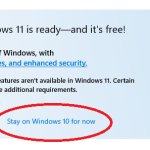Category: Windows 11
Studying The Science of Retail Since 1979
Upgrading to Windows 11? Read This First.

If you use any Windows 10 computer these days you and your staff may have recently noticed that the existing Windows 10 version you’re running has been recommending upgrading to Windows 11 in va… Read More
